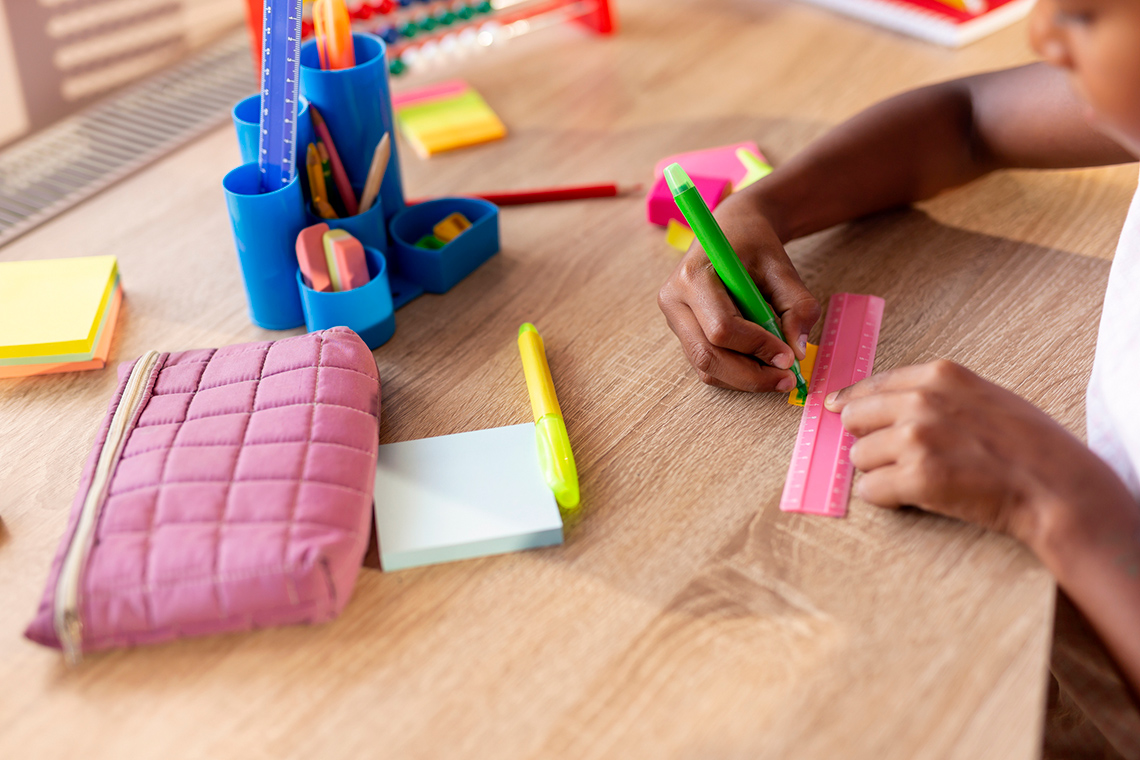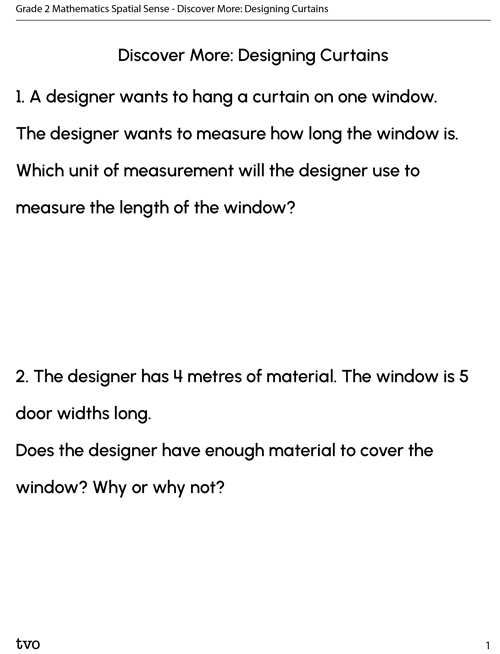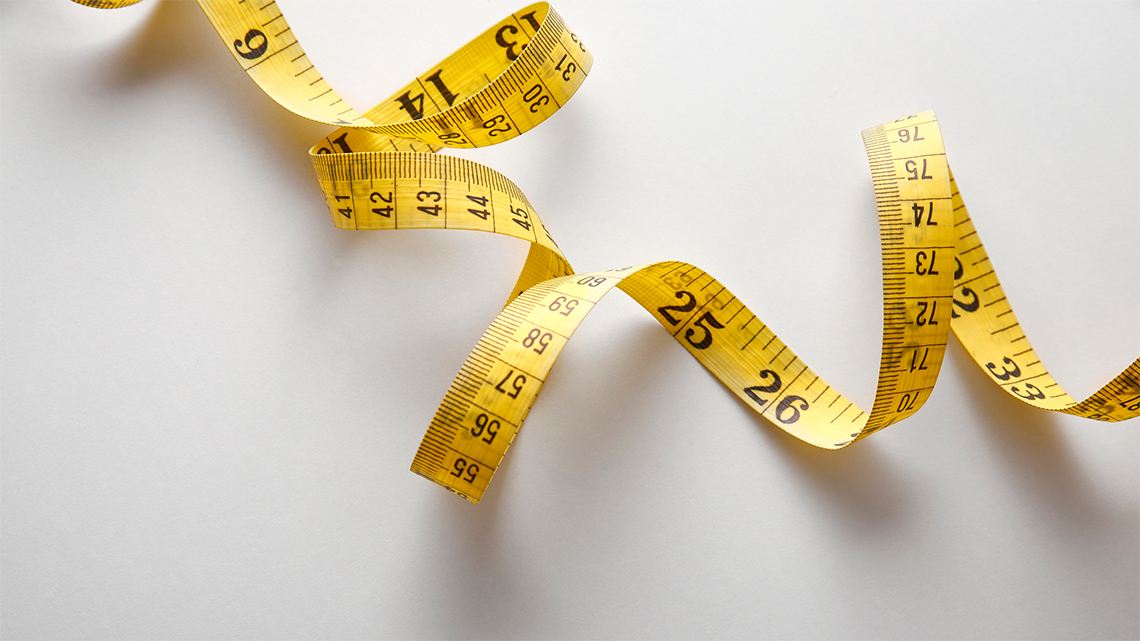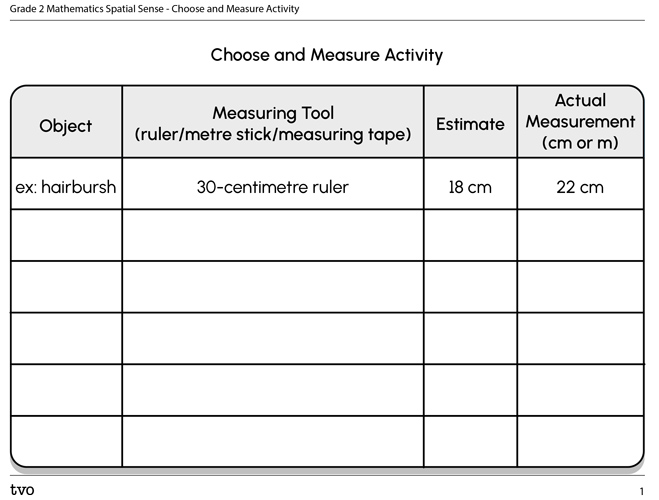Minds On
Identify measuring tools
Explore the various measuring tools:
Brainstorm
Let’s think!
After exploring the measuring tools, reflect on the following question:
- Which ones do not belong? How do you know?
Record your ideas in a notebook or a method of your choice.
Action
Measuring tools
Let’s explore different measuring tools that we can use to measure length.
Rulers
Rulers are marked off in units.
For example, the following ruler is marked only in centimetres or cm. It starts at 0 centimetres and goes up to 30 centimetres.

A ruler that is this length can be used to measure things that are short, like a crayon, a pencil case, or a remote control.
What can we use to measure objects that are longer?
Metre stick
A metre stick is a lot like the 30-centimetre ruler, but it starts at 0 centimetres and goes to 100 centimetres.
This is because there are 100 centimetres in 1 metre.
A metre stick can be used to measure things that are long, like a bicycle, a bookshelf, or a sofa.

Measuring tape
Similar to a ruler and a metre stick, a measuring tape is marked off in units.
The main difference is that it is made of flexible material which bends.

Brainstorm
Let’s think!
Consider the following question:
- When might we use a measuring tape over a ruler or a metre stick?
Press ‘Let’s check!’ to examine the best unit of measure for each object.
Select an appropriate measuring tool
Which measuring tool would be the best for measuring each object?
Consider which measuring tool would be the best for measuring each object.
Sort each object. Record your ideas in your notebook or another method of your choice.
Let’s check!
Press ‘Show results’ to access which measuring tool would be the best for measuring each object.
| 30-centimetre ruler | Metre stick | Measuring tape |
|---|---|---|



|


|

|
Using a measuring tool
When we measure the length of an object, we measure the distance between the starting point and the end point of the object.

- Start by lining up the zero with the edge of the object.
- For example, if using a ruler to measure a pencil, the tip of the pencil should line up with the zero on the ruler.
Student Tips
Student tips
Make sure that your measuring tools run along the side of the object you are measuring.
- Then, determine where the end of the object stops on the ruler.
- For example, the end of the pencil stops at 17 cm.

-
Record the measurement that includes a number and a unit using a method of your choice.
- For example, in step 2, the length of the pencil is 17 cm.
- 17 is the number and cm (centimetres) is the unit.
Let’s measure!
Let’s measure each object using the provided centimetre ruler.
Complete the Measuring Activity in your notebook or use the following fillable and printable document. You can also use a method of your choice.
Press ‘Let’s check!’ to access the measurements for each object.
- Pencil measures 14 cm.
- Paperclip measures 4 cm.
- Glue stick measures 7 cm.
- Eraser measures 5 cm.
Test Your Skills!
Measuring accurately
Learner A, Learner B, and Learner C took turns measuring a glue stick.
Who measured the glue stick accurately? How do you know?
Record your thinking using a method of your choice.
Press ‘Let’s check!’ to access who measured accurately.
Learner B measured the glue stick correctly.
The edge of the glue stick is lined up with the zero on the ruler and runs along the side of the ruler.
Learner A did not line up the glue stick with the zero on the ruler, and Learner C’s glue stick does not run along the side of the ruler.
Consolidation
Choose and measure

- Select five objects in your learning space to measure.
- Determine which measuring tool would be the best to measure each object and explain why.
- As an option, use a measuring tool to measure the length of your selected objects.
- Record the name of the object, the measuring tool you would use, and if possible, the actual length of the object in centimetres (cm) or metres (m).
Complete the Choose and Measure Activity in your notebook or use the following fillable and printable documents. You can also use a method of your choice.
Measure and connect
Reflect on your learning through the following questions:
- Describe how you would measure a pencil that is 13 centimetres long.
- How might you measure something that is longer than your ruler?
- When do we use centimetres to measure? When do we use metres to measure?
- Why is it useful to have two different units that we can use?
Record your ideas in your notebook or another method of your choice.
Reflection
How do you feel about what you have learned in this activity? Which of the next four sentences best matches how you are feeling about your learning? Press the button that is beside this sentence.
I feel...
Now, record your ideas about your feelings using a voice recorder, speech-to-text, or writing tool.
Press ‘Discover More’ to extend your skills.
Discover More

Consider the following two measuring questions.
- A designer wants to hang a curtain on one window. The designer wants to measure how
long the
window is.
- Which unit of measurement will the designer use to measure the length of the window?
-
The designer has 4 metres of material. The window is 5 door widths long.
- Does the designer have enough material to cover the window? Why or why not?
Complete the Discover More: Designing Curtains in your notebook or use the following fillable and printable documents. You can also use a method of your choice.

Press the Activity button to access Discover More: Designing Curtains.
Activity (Open PDF in a new tab)





